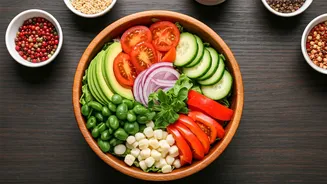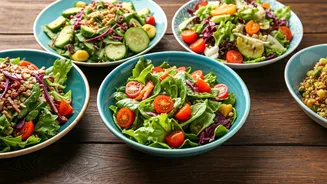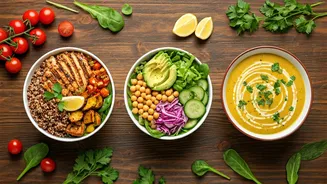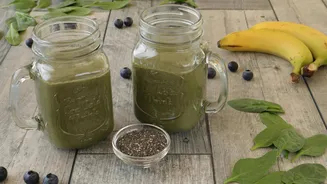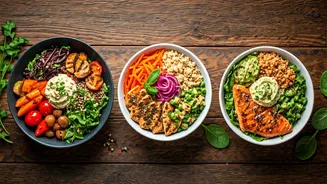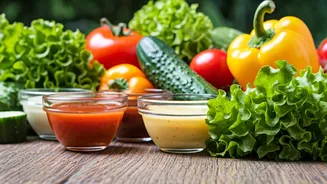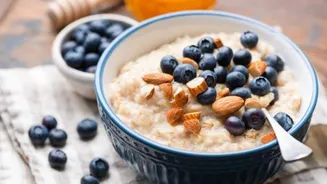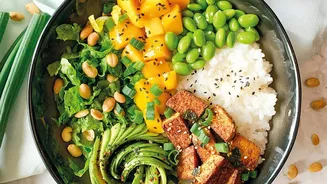Salads: A Healthy Start
Salads are a cornerstone of healthy eating, offering a fantastic blend of vitamins, minerals, and fiber. They provide a foundation for a balanced diet,
incorporating fresh vegetables, fruits, lean proteins, and healthy fats. Salads are incredibly adaptable, allowing you to tailor them to your dietary needs and taste preferences. Whether you are looking for a light lunch, a side dish, or a complete meal, a well-crafted salad can satisfy your cravings while nourishing your body. The recipes ahead present a diverse range of salad options, emphasizing freshness, ease of preparation, and delicious flavor combinations. From the simple elegance of a classic Greek salad to the complex layers of a hearty Cobb salad, each recipe encourages you to explore the vast possibilities that salads have to offer.
Classic Caesar Salad
The Caesar salad, a timeless favorite, begins with crisp romaine lettuce as its base, ensuring each bite is refreshingly crunchy. A creamy dressing, made with a blend of mayonnaise, olive oil, lemon juice, garlic, and Parmesan cheese, coats the leaves, providing a rich and tangy flavor. Croutons, toasted to golden perfection, add a delightful textural contrast, enhancing the overall experience. Anchovies, traditionally included, provide a savory depth that complements the other ingredients. Alternatively, for vegetarian versions, the anchovies can be omitted without compromising the salad's taste. The Caesar salad, with its balanced flavors and textures, remains a beloved choice, perfect as a light meal or a flavorful side dish.
Greek Salad's Freshness
The Greek salad celebrates fresh ingredients with simplicity and vibrant flavors. At its core are ripe tomatoes, cucumbers, red onion, and Kalamata olives, delivering a burst of freshness and a touch of saltiness. A generous amount of creamy feta cheese, crumbled over the top, provides a salty and tangy counterpoint to the vegetables. The dressing, a simple mix of olive oil, red wine vinegar, oregano, and a pinch of salt and pepper, brings all the elements together. The Greek salad is known for its bright colors and refreshing taste. It's an excellent choice for a summer meal or a refreshing side dish, offering both health and flavor.
Cobb Salad's Heartiness
The Cobb salad is a hearty and satisfying meal, a beautiful composition of textures and tastes. It typically features crisp lettuce, grilled chicken or turkey, crispy bacon, hard-boiled eggs, avocado, tomatoes, and blue cheese. The combination offers a rich blend of proteins, fats, and fresh produce. The key to a great Cobb salad lies in the balance of flavors and textures. The smoky bacon, creamy avocado, and tangy blue cheese complement the juicy chicken and fresh vegetables. A simple vinaigrette, often made with red wine vinegar, olive oil, and Dijon mustard, ties everything together. The Cobb salad makes a satisfying meal, perfect for any time of the day.
Caprese Salad Delight
The Caprese salad is a celebration of simplicity, highlighting the fresh, clean flavors of Italian cuisine. It consists of thick slices of ripe tomatoes and fresh mozzarella cheese, arranged alternately on a platter. The combination is visually appealing, with vibrant red tomatoes and creamy white mozzarella creating a beautiful contrast. Fresh basil leaves, nestled between the tomatoes and mozzarella, provide a fragrant aroma and a subtle peppery note. A drizzle of extra virgin olive oil and a sprinkle of balsamic glaze adds richness and depth to the flavors. The Caprese salad is a delightful appetizer, a light lunch, or a flavorful side dish, perfect for showcasing the season's best ingredients.
Waldorf Salad's Sweetness
The Waldorf salad is a classic that combines sweet and crunchy elements. It typically features crisp apples, celery, and walnuts, tossed in a creamy mayonnaise-based dressing. The sweetness of the apples is balanced by the celery’s slight bitterness, and the walnuts provide a satisfying crunch. The dressing adds richness and a subtle tang. Sometimes, grapes or raisins are added for extra sweetness and texture. The Waldorf salad is often served as a side dish or appetizer, bringing together a variety of textures and flavors. It is a simple yet elegant salad, perfect for any occasion.
Asian-Inspired Salads
Asian-inspired salads offer a vibrant mix of flavors and textures. They often include ingredients like shredded cabbage, carrots, bell peppers, edamame, and crispy noodles for a satisfying crunch. Dressings can vary, but frequently incorporate soy sauce, sesame oil, rice vinegar, and a touch of ginger and garlic. To add protein, these salads often feature grilled chicken, tofu, or shrimp. The combination of sweet, sour, and savory flavors makes these salads both delicious and exciting. Many recipes incorporate fresh herbs like cilantro and mint, enhancing the overall freshness of the salad.
Quinoa Salad Options
Quinoa salads are a nourishing and versatile option, providing a complete protein source along with a variety of vegetables and flavorings. Cooked quinoa serves as the base, offering a nutty flavor and a satisfying texture. The salads can incorporate ingredients such as bell peppers, cucumbers, tomatoes, red onion, and herbs like parsley or cilantro. Dressings often feature lemon juice, olive oil, and sometimes a touch of tahini or other spices. Quinoa salads are highly adaptable, allowing for customization based on dietary needs or preferences. They are ideal for a light lunch, a side dish, or a packed lunch option, as they hold up well over time.
Pasta Salad Flavors
Pasta salads are a popular choice, offering a satisfying and customizable meal or side dish. They typically feature cooked pasta, combined with a variety of ingredients like vegetables, cheeses, and proteins. Common ingredients include cherry tomatoes, olives, cucumbers, bell peppers, mozzarella or feta cheese, and often, Italian meats like salami or pepperoni. Dressings can range from creamy Italian to simple vinaigrettes. The type of pasta used can also vary, with options like penne, rotini, or farfalle providing a range of shapes and textures. Pasta salads are perfect for potlucks, picnics, and casual gatherings, offering a delicious and easy-to-prepare dish that pleases a crowd.
Seasonal Salad Ideas
Seasonal salads celebrate the best ingredients of the moment. In spring, this might mean vibrant asparagus, tender peas, and fresh strawberries. Summer salads might incorporate ripe tomatoes, sweet corn, and juicy peaches. Fall salads often feature roasted root vegetables, apples, and toasted nuts. Winter salads can include hearty greens, citrus fruits, and pomegranates. The beauty of seasonal salads is their freshness and flavor. Adjusting your salad ingredients based on what's in season enhances the taste and provides a variety of nutrients. By embracing seasonal ingredients, you can ensure that your salads are always at their peak flavor and nutritional value.
Tips for Great Salads
To make exceptional salads, consider these helpful tips. Start with fresh, high-quality ingredients, including crisp greens, ripe vegetables, and flavorful dressings. Vary the textures in your salad, combining soft, crunchy, and chewy elements to make each bite interesting. Properly wash and dry your greens to ensure the dressing adheres well. Prepare ingredients ahead of time to save time later, but add the dressing just before serving to prevent the salad from becoming soggy. Experiment with different flavor combinations to find your favorites, and don't be afraid to try new ingredients or dressings. Taste and adjust seasonings as needed, adding salt, pepper, or other spices to enhance the flavors. A well-made salad is both satisfying and flavorful.
Dressing Options Galore
Salad dressings come in various forms, offering different flavors and textures to complement your ingredients. Vinaigrettes, typically made with oil and vinegar, provide a light and tangy option. Creamy dressings, such as ranch or blue cheese, add richness. Asian-inspired dressings, like sesame ginger or peanut, offer a unique and flavorful twist. When making your dressing, balance the flavors – acidity from vinegar or lemon juice, oil for richness, and seasonings for complexity. Store-bought dressings can be convenient, but making your own allows you to control the ingredients and adjust the flavors to your liking. The perfect dressing elevates your salad from a basic side dish into a culinary delight.
Building Balanced Salads
A balanced salad should incorporate a variety of nutrients to provide a complete meal. Start with a base of leafy greens, such as romaine lettuce, spinach, or mixed greens. Add colorful vegetables, such as tomatoes, cucumbers, peppers, and carrots, for vitamins and minerals. Include a source of protein, like grilled chicken, fish, tofu, beans, or hard-boiled eggs, for satiety. Incorporate healthy fats, such as avocado, nuts, seeds, or a drizzle of olive oil, to provide flavor and support nutrient absorption. The combination of these elements ensures your salad is both nutritious and satisfying. By focusing on balance, you create a meal that fuels your body and promotes overall health.
Adding Proteins to Salads
Adding protein to your salad significantly enhances its nutritional value and makes it more filling. Options for protein are diverse and versatile. Grilled chicken, either plain or marinated, adds a lean protein source. Flaky fish, such as salmon or tuna, provides healthy fats. Beans, like chickpeas or black beans, offer fiber and plant-based protein. Tofu, marinated and pan-fried or baked, is a great option for vegetarians. Eggs, hard-boiled or poached, are another quick and easy protein addition. When adding protein, consider how it complements other ingredients in the salad, choosing flavors and preparations that enhance the overall taste and texture. Adding protein is a great way to transform a simple salad into a complete and satisfying meal.
Storage & Prep Strategies
Proper storage and preparation are essential to maintaining the freshness and quality of your salads. Wash and dry all greens and vegetables thoroughly before storing them. Store greens in a clean container with a paper towel to absorb excess moisture. Chop vegetables and prepare proteins in advance to save time when assembling the salad. Store ingredients separately until ready to assemble to prevent sogginess. Dress the salad just before serving, or keep the dressing separate so that the salad maintains its crisp texture. By following these preparation and storage tips, you can enjoy fresh, delicious salads at any time.
